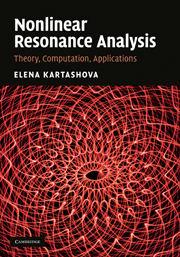1 - Exposition
Published online by Cambridge University Press: 06 December 2010
Summary
“But there's need for some proof…” Berlioz began. “There's no need for any proofs,” replied the professor and he began to speak softly, while his accent for some reason disappeared: “It's all very simple…
M. Bulgakov Master and MargaritaAn easy start
As with every new theory, nonlinear resonance analysis has not come ex caelo. On the contrary, as Newton said: “If I have seen further it is only by standing on the shoulders of giants.” The giants to be grateful to now are Galileo Galilei (1564–1642), Jean Baptiste Joseph Fourier (1768–1830), and Jules Henri Poincaré (1854–1912). The father of modern physics, an Italian, Galileo Galilei, fascinated by the movement of a simple pendulum, identified one of the most important natural phenomena – resonance. French politician and mathematician Fourier, trying to understand what happens when a hot piece of metal rod is put into water, developed the mathematical apparatus – Fourier analysis – for describing solutions to linear partial differential equations (PDEs), without which no area of contemporary science is conceivable. Another French mathematician, Henri Poincaré, used Fourier analysis in order to give a strict mathematical definition of resonance and developed a method – Poincaré transformation – allowing, under some assumptions, to reduce the search for solutions to a nonlinear PDE to the search for resonances. This way the foundations of nonlinear resonance analysis were laid.
- Type
- Chapter
- Information
- Nonlinear Resonance AnalysisTheory, Computation, Applications, pp. 1 - 29Publisher: Cambridge University PressPrint publication year: 2010



